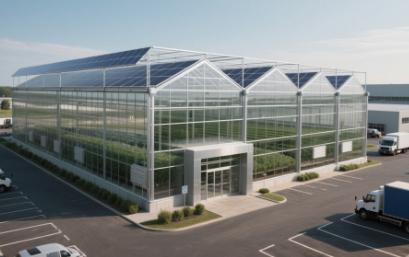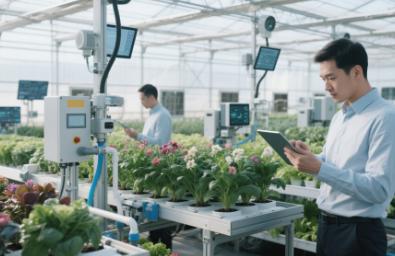Definition and Components of Commercial Smart Greenhouse
A commercial smart greenhouse is a technologically advanced agricultural facility designed to optimize crop production through automated systems and data-driven decision-making. Unlike traditional greenhouses, which rely heavily on manual labor and basic environmental controls, commercial smart greenhouses integrate sophisticated technologies to create an ideal growing environment for a variety of crops. The key components of a commercial smart greenhouse include:
Structural Framework: The physical structure of the greenhouse, typically made from durable materials like steel or aluminum, provides a stable environment for crops. It is designed to withstand various weather conditions and support the installation of advanced equipment.
Climate Control Systems: These systems regulate temperature, humidity, and air circulation. They often include heating, cooling, and ventilation units that work together to maintain optimal growing conditions.

Irrigation and Fertigation Systems: These systems deliver water and nutrients directly to the plant roots. They are designed to be highly efficient, reducing water waste and ensuring that plants receive the right amount of nutrients for healthy growth.
Lighting Systems: Advanced lighting solutions, such as LED grow lights, provide the necessary light spectrum for photosynthesis. These lights can be adjusted to simulate natural sunlight and optimize plant growth.
Sensors and Monitoring Devices: Sensors continuously monitor environmental conditions and plant health. They provide real-time data on temperature, humidity, light levels, soil moisture, and more. This data is crucial for making informed decisions about crop management.
Automation and Control Systems: Central control units process data from sensors and automate various tasks, such as irrigation, lighting, and climate control. These systems can be programmed to respond to specific conditions, ensuring that the greenhouse environment remains optimal for crop growth.
The Role of Sensors and Data in Commercial Smart Greenhouses
Sensors and data play a critical role in the operation of commercial smart greenhouses. Sensors collect real-time data on various environmental parameters and plant health indicators. This data is then analyzed by the control system to make automated adjustments and provide actionable insights to growers. For example:
Temperature Sensors: Monitor the air and soil temperature to ensure it stays within the optimal range for crop growth.
Humidity Sensors: Measure the relative humidity in the greenhouse, helping to prevent issues like mold and mildew.
Light Sensors: Detect light levels and adjust artificial lighting to provide the right amount of photosynthetic active radiation (PAR).
Soil Moisture Sensors: Measure the moisture content in the soil, allowing for precise irrigation scheduling.
CO₂ Sensors: Monitor CO₂ levels, which are crucial for photosynthesis. Some greenhouses also include CO₂ enrichment systems to enhance plant growth.
By leveraging this data, growers can make informed decisions about crop management, leading to higher yields, better quality produce, and reduced resource consumption.
Comparison of Commercial Smart Greenhouses and Traditional Greenhouses

When comparing commercial smart greenhouses to traditional greenhouses, several key differences emerge:
Automation and Precision: Smart greenhouses offer a higher degree of automation and precision in environmental control. Traditional greenhouses often rely on manual adjustments and basic controls, which can be less precise and more labor-intensive.
Resource Efficiency: Smart greenhouses are designed to be highly efficient in their use of water, energy, and nutrients. Advanced irrigation and fertigation systems, combined with energy-efficient technologies, can significantly reduce resource consumption and operating costs.
Data-Driven Decision-Making: Smart greenhouses provide growers with real-time data and analytics, enabling them to make informed decisions about crop management. Traditional greenhouses typically lack this level of data integration and rely more on experience and intuition.
Scalability and Flexibility: Smart greenhouses can be scaled up or down more easily to meet changing production needs. They also offer greater flexibility in terms of crop selection and growing conditions.
Environmental Impact: Smart greenhouses often have a smaller environmental footprint due to their efficient use of resources and reduced reliance on chemical inputs.
Different Types of Commercial Smart Greenhouses
Commercial smart greenhouses come in various types, each tailored to specific growing needs and conditions:
Greenhouses with Integrated Hydroponics: These greenhouses use hydroponic systems to grow plants without soil. Nutrient-rich water solutions are delivered directly to the plant roots, providing precise control over nutrient uptake and water usage.
Vertical Farming Greenhouses: Designed for urban environments, vertical farming greenhouses stack layers of crops to maximize space. They often use LED lighting and advanced climate control systems to optimize growth in a compact footprint.
Greenhouses with Solar Panels: These greenhouses incorporate solar panels to generate renewable energy, reducing reliance on external power sources and lowering energy costs.
Greenhouses with Advanced Climate Control: These greenhouses feature advanced climate control systems that can precisely regulate temperature, humidity, and air circulation. They are ideal for growing a wide range of crops in various climates.
Greenhouses with Automated Harvesting Systems: Some commercial smart greenhouses include automated harvesting systems that reduce labor costs and increase efficiency. These systems can be particularly useful for large-scale production.
Each type of commercial smart greenhouse offers unique advantages and can be customized to meet specific agricultural needs.
Conclusion
Commercial smart greenhouses represent a significant advancement in agricultural technology, offering precise environmental control, efficient resource use, and data-driven decision-making. They provide a sustainable and scalable solution for modern farming, helping growers to maximize yields and reduce costs. As technology continues to evolve, commercial smart greenhouses will play an increasingly important role in meeting the world's growing food demands.
Welcome to have a further discussion with us.
Phone: +86 15308222514
Email: Rita@cfgreenhouse.com
Post time: Jul-09-2025







 Click to Chat
Click to Chat